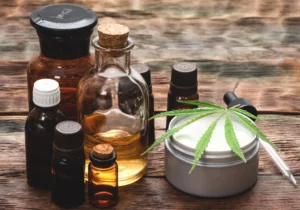On Jan. 11, I was honored to moderate the panel discussion hosted by Women Grow NYC, co-sponsored by HelloMD and New York medical marijuana dispensary PharmaCannis. The panelists—medical professionals, family therapists, nutritionists and cannabis executives—wanted to examine the ever-growing opioid crisis and the role cannabis could play in helping free us from this deadly epidemic. I shared some of my thoughts, including my personal experience replacing Vicodin with medicinal marijuana.
FOLLOW US ON FACEBOOK & INSTAGRAM
The Reality of Pain, Opioids & Death in America
In 2016, nearly 65,000 people died in the United States from drug overdoses. Two-thirds of those deaths were attributed to the powerful class of drugs called opioids. It’s estimated that an average of 90 people a day are dying from opioid overdoses, and that number seems to be increasing every year. As the number of deaths climbs precipitously higher, the U.S. government acknowledged the depth of the problem recently and declared the opioid epidemic to be a public “health emergency.” However, no additional federal funds have been allocated towards the problem.
Some studies suggest that 110 million Americans will suffer from chronic pain—defined as pain that lasts for more than 90 days—at some point in their life. For the past 20 years, opioids have been the go-to solution for helping people combat chronic pain. Unfortunately, they’re highly addictive, often leading patients to take more and more as they affect the brain’s pleasure/reward system. Because of the number of opioid receptors in the brainstem, they can also be deadly when the dose is too high or if taken in combination with other drugs, such as sleeping pills.
How I Went From Vicodin to Cannabis to Treat Chronic Pain
As a life-long migraine sufferer, I dealt with my share of chronic pain. What I can tell you is that once you’re in pain, you’ll do whatever you can to get out of it. For this reason, after I went through much trial and error, I landed on Vicodin as my trusty solution for treating migraine-related pain. Although I wasn’t happy about using an opiate frequently, it was honestly the only drug that allowed me to remain semi- functional. However, as my usage of Vicodin went up, so did my concern about becoming addicted.
A good friend of mine at some point came to me and said, “Why don’t you consider using marijuana for your migraines?” I scoffed at this suggestion and thought, “Maybe for other people, but that’s not me.” As with so many others, cannabis truly was my medication of last resort—I was out of options. Fortunately, I live in California where finding a medical marijuana dispensary is as easy as finding a Starbucks.
After receiving my medical recommendation, I found myself at The Apothecarium, a high-end dispensary in San Francisco with a highly trained budtender named Aaron. He suggested I start on a protocol of high-CBD tinctures and vape pens. Within three months of starting treatment with cannabis, I was managing my pain effectively, and within six months I was preventing my migraines entirely.
Happily, I can say that in the past three years I haven’t experienced a migraine. For me, cannabis was a silver bullet, and I was able to eliminate opioids entirely. However, most people aren’t as lucky when opioids are introduced into a chronic pain treatment protocol.
How Did Opioids Become So Pervasive Anyway?
For much of the ‘80s and ‘90s, the medical community had “opiophobia,” or fear of prescribing opioids. However, a small medical study published by two Boston University researchers named Porter and Jick altered how America viewed opioids. They declared in a one-paragraph letter to the editor in the New England Journal of Medicine that only four out of nearly 12,000 cases resulted in a narcotics addiction.
Although Porter and Jick’s study wasn’t peer reviewed or performed in a clinical setting, this one finding went on to be cited more than 900 times by medical and scientific journals. By 1996, when OxyContin was released on the market by Purdue Pharmaceuticals, our community at large was conditioned to believe opioids weren’t addictive, when in fact we now know the opposite to be true.
How Opioids Were Marketed to the Masses
The release of OxyContin into the market kicked off a massive marketing campaign to get America hooked. Not only was OxyContin more powerful than any other opioid to date, it was touted to give pain relief from 8 a.m. to 8 p.m. with only two daily doses necessary. The American people were marketed to on TV and in print and were told that:
- the rate of addiction was less than 1%.
- there were no serious medical side effects.
- opioids don’t wear out; they keep on working.
- they should be used far more for the treatment of chronic pain.
From 1996 onwards, the mortality rate skyrocketed.
Can Cannabis Really Replace Opioids for Pain Relief?
We’ve been told for the past 20 years that opioids aren’t addictive—which they are—and that they’re the best option for treating chronic pain—and they’re not. The reality is, cannabis is far less addictive than opioids, and new research shows that it’s more effective in treating chronic pain. It also happens to be safer—marijuana has never killed anyone. It’s impossible to die by cannabis overdose.
Although many people say that not enough research has been done to back the claim that cannabis is an effective alternative to other medications, there’s a mountain of evidence starting to surface. In the past year, The National Academy of Science stated, “Adults with chronic pain are more likely to experience clinically significant levels of pain reduction when treated with cannabis or cannabinoids.”
Additionally, the National Institute on Drug Abuse (NIDA) recently funded two studies exploring the relationship between marijuana legalization and adverse outcomes associated with prescription opioids. NIDA found that “[a]ccess to medical marijuana dispensaries is associated with lower levels of opioid prescribing, lower self-report of non-medical prescription opioid use, lower treatment admissions for prescription opioid use disorders, and reduction in prescription opioid overdose deaths.”
RELATED: HOW CANNABIS CAN BREAK THE CYCLE OF OPIOID ABUSE
HelloMD-UC Berkeley Study: Patients Prefer Marijuana to Opioids
In 2017, HelloMD conducted a study in conjunction with UC Berkeley which looked at cannabis as a substitute for opioid-based pain medication. Three thousand patients participated in the largest study of its kind done to date. The study was led by a trio of experts in their field:
- Amanda Reiman PhD, MSW, of UC Berkeley and the Drug Policy Alliance
- Perry Solomon, MD, chief medical officer of HelloMD
- Mark A. Welty PhD, NCC, LPCC-S, LSW, of Kent State University
Among the study’s key findings were:
- 97% strongly agreed/agreed that they could decrease their opioid use when using cannabis.
- 92% strongly agreed/agreed that they prefer cannabis to treat their medical condition.
- 81% strongly agreed/agreed that cannabis by itself was more effective than taking cannabis with opioids. The results were similar when using cannabis with non-opiate-based pain medications.
In states where medical marijuana is legal and readily available, researchers have seen a 24.8% reduction in opioid-related overdoses. Yet, members of the medical community are still hesitant to refer patients
to marijuana as a possible alternative to opiate use for chronic pain or many other medical conditions.
How to Disrupt the Opioid Epidemic With Medical Marijuana
In fact, PharmaCannis, a well-established medical cannabis provider in New York and Illinois, refers to
“windows of opportunity” to get us out of the opioid epidemic. They describe three
windows of opportunity—before, during and after opioid dependency—where it’s possible to disrupt
the opioid epidemic with medical marijuana.
Before: Prior to opioids being introduced, a patient can experiment with cannabis to see if it works
for their chronic pain.
During: If a patient has been introduced to opioids, cannabis can be used as an opioid reduction
strategy.
After: If a patient has become addicted to heroin or fentanyl, cannabis can be used as an adjunct
anti-addiction therapy to replace treatments such as methadone.
Marijuana as “Exit Drug” From the Opioid Epidemic
Based on recent findings, both through research and mounting anecdotal evidence, cannabis may be the exit drug to the opioid epidemic. Although mainstream America has yet to adopt cannabis en masse as the de facto replacement for opioids, there’s current momentum for a significant change in how we address the treatment of chronic pain—and cannabis as a solution.
My personal story of using cannabis in lieu of opioids, to both manage and prevent my chronic pain, was the birthplace of HelloMD. Since our founding, we’ve treated thousands of patients and have seen first-hand how effective cannabis can be in the treatment of chronic pain.
Cannabis has the potential to improve the overall quality of a chronic pain sufferer’s life. Studies and anecdotal evidence are starting to show that marijuana is more effective than opioids are—and it won’t kill 65,000 people a year. It’s time to take cannabis seriously as a medicine that can help millions of people.






